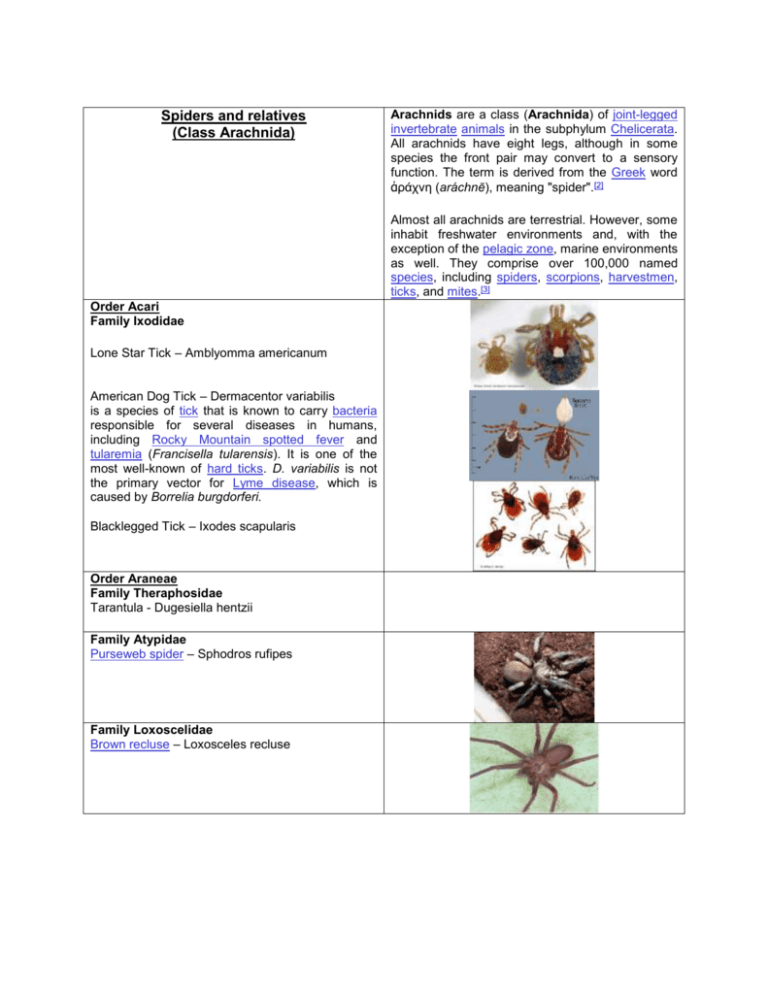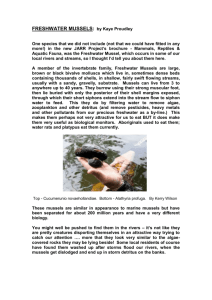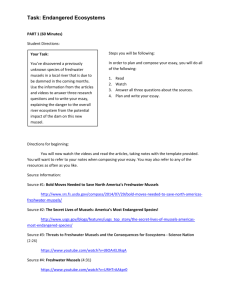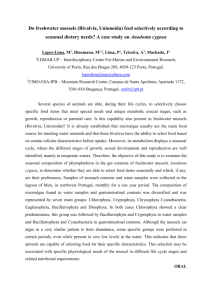Family Ixodidae
advertisement

Spiders and relatives (Class Arachnida) Arachnids are a class (Arachnida) of joint-legged invertebrate animals in the subphylum Chelicerata. All arachnids have eight legs, although in some species the front pair may convert to a sensory function. The term is derived from the Greek word ἀράχνη (aráchnē), meaning "spider".[2] Almost all arachnids are terrestrial. However, some inhabit freshwater environments and, with the exception of the pelagic zone, marine environments as well. They comprise over 100,000 named species, including spiders, scorpions, harvestmen, ticks, and mites.[3] Order Acari Family Ixodidae Lone Star Tick – Amblyomma americanum American Dog Tick – Dermacentor variabilis is a species of tick that is known to carry bacteria responsible for several diseases in humans, including Rocky Mountain spotted fever and tularemia (Francisella tularensis). It is one of the most well-known of hard ticks. D. variabilis is not the primary vector for Lyme disease, which is caused by Borrelia burgdorferi. Blacklegged Tick – Ixodes scapularis Order Araneae Family Theraphosidae Tarantula - Dugesiella hentzii Family Atypidae Purseweb spider – Sphodros rufipes Family Loxoscelidae Brown recluse – Loxosceles recluse Family Pholicidae Cellar spider – Pholcus phalangioides Family Theridiidae House spider – Achaearanea tepidariorum Black widow – Latrodectus mactans Bowl & doily spider – Frontinella pyramitela Family Araneidae Golden Garden Spider – Argiope aurantia Banded Argiope – Argiope trifasciata Spined Micrathena – Micrathena gracilis Family Tetragnathidae Long-jawed orbweaver – Tetragnatha sp. Family Agelenidae Funnel web weaver – Agelenopsis sp. Family Pisauridae Fishing Spider – Dolomedes tenebrosus Family Lycosidae Wolf Spider – Lycosa sp. Family Thomisidae Crab Spider – Misumena sp. Family Salticidae Jumping Spider – Marpissa pikei White-spotted jumping Spider – Phidippus audax Family Uloboridae Featherlegged Spider – Uloborus glomosus Order Solifugae Family Solpugidae Sun spider – Eramobatus pallipes Order Scorpiones Family Buthidae Scorpion – Centruroides sp. Order Opiliones Family Phalangidae Daddy long-legs – Mitopus sp. Centipedes (Class Chilopoda) Centipedes (from Latin prefix centi-, "hundred", and Latin pes, pedis, "foot") are arthropods belonging to the class Chilopoda and the Subphylum Myriapoda. They are elongated metameric animals with one pair of legs per body segment. A key trait uniting this group is a pair of venom claws or forcipules formed from a modified first appendage. This also means that centipedes are an exclusively predatory taxon, which is uncommon Order Scutigeromorpha House centipede – Scutigera sp. Order Geophilomorpha Soil centipede – Arenophilus sp. Order Scolopendromorpha Centipede – Scolopendra sp. Millipedes (Class Diplopoda) Millipedes, known as shongololos in South African English,[2] are arthropods that have two pairs of legs per segment (except for the first segment behind the head which does not have any appendages at all, and the next few which only have one pair of legs). Each segment that has two pairs of legs is a result of two single segments fused together as one. Most millipedes have very elongated cylindrical bodies, although some are flattened dorso-ventrally, while pill millipedes are shorter and can roll into a ball, like a pillbug. Millipedes are detritivores and slow moving. Most millipedes eat decaying leaves and other dead plant matter, moisturising the food with secretions and then scraping it in with the jaws. However they can also be a minor garden pest, especially in greenhouses where they can cause severe damage to emergent seedlings. Signs of millipede damage include the stripping of the outer layers of a young plant stem and irregular damage to leaves and plant apices. Unlike centipedes however, millipedes are by nature not predators, and due to their slow, nonaggressive behavior and simple diet of decomposing leaves, are easy to keep and ideal as pets. Crabs and relatives (Class Crustacea) Order Isopoda Isopods are an order of peracarid crustaceans, including familiar animals such as woodlice and pill bugs. The name Isopoda derives from the Greek iso meaning "same" and pod meaning "foot" Isopods are relatively small crustaceans with seven pairs of legs of similar size and form, ranging in size from 300 micrometres (0.012 in) to nearly 50 centimetres (20 in) in the case of Bathynomus giganteus.[1] They are typically flattened dorsoventrally, although many species deviate from this plan, particularly those from the deep sea or from ground water.[1] Isopods lack an obvious carapace, which is reduced to a "cephalic shield" covering only the head.[4] Gas exchange is carried out by specialised gill-like pleopods towards the rear of the animal's body. In terrestrial isopods, these are often adapted into structures which resemble lungs, and these "lungs" are readily visible on the underside of a woodlouse.[1] Eyes, when present, are always sessile, never on stalks.[4] They share with the Tanaidacea the fusion of the last abdominal body segment with the telson, forming a "pleotelson",[4] and the first body segment of the thorax is fused to the head. The pereiopods are uniramous, but the pleopods are biramous.[4] Pillbug – Armadillidum vulgare Sowbug – Oniscus sp. Armadillidiidae is a family of woodlice, a terrestrial crustacean group in the order Isopoda. Unlike members of the family Porcellionidae, members of this family can roll into a ball, giving them their common name of "pill bug", or the more recent and increasingly popular terms, "doodlebug" or "roly poly" which have been used regionally as early as 1968. [1] The best known species in the family is Armadillidium vulgare, the common pill bug. These arthropods commonly feed on decaying vegetation and are found under logs, under animal excrement, garbage pails or any other place where moisture can be found. Moisture is essential to pill bugs due to their breathing organs, which are like gills. Although they often thrive in damp areas, pill bugs have often been known to live in dry beds. Their defensive posture is curling up into a ball to present their armored exterior. They are the unique prey of the woodlouse spider and play host to specialized parasitoids in the fly family Rhinophoridae. Order Decapoda Devil Crayfish – Cambarus diogenes The devil crawfish is perhaps our most widely distributed crayfish, occurring over all except the west-central part of the state. It lives in burrows in timbered or formerly timbered areas along the floodplains of streams. Its presence is often revealed by conspicuous mud chimneys. In early spring, young and some adults occur in roadside pools and other temporary waters. Northern Crayfish – Orconectes virilis The pincers are green with orange tips, and in adults are conspicuously studded with whitish knobs. Paired blotches run lengthwise along the abdomen. Prairie Crayfish – Procambarus gracilis The pincers are short and heavy, and the high, dome-shaped carapace is longer than the abdomen. The prairie crayfish occurs widely in grasslands and former grasslands of the Prairie Region. It lives in burrows that are often a long distance from any surface water. These may be six feet of more in depth. Most public prairies in Missouri support large populations, but this crayfish is seldom seen by visitors because of its secretive habits. The prairie crayfish superficially resembles the devil crawfish, another burrowing species. The devil crawfish is never a uniform bright red, as are many adult prairie crayfish. Males of the two species are readily separated by the shape of the gonopod tips (nearly straight in the prairie crayfish, strongly curved in the devil crawfish). Bivalve Mollusks (Class Bivalvia) Freshwater mussels (Mollusca: Unionacea) are a fascinating group of animals that reside in our streams and lakes. They are frontline indicators of environmental quality and have ecological ties with fish to complete their life cycle and colonize new habitats. As filter-feeders, they can help improve both water quality and clarity, and they are an important part of the aquatic food web. Kansas is the home of 40 living species of native freshwater mussels. Another 8 species were here in the past but are no longer found in our rivers, streams and lakes (see extirpated species). Over half of the extant species are listed as threatened (T), endangered (E) or species-in-needofconservation (SINC). This is not surprising, because freshwater mussels have been identified as one of the most imperiled groups of animals in North America. The major threats to mussels are pollution, dewatering of streams, stream channelization and dams. Byssal thread – a fibrous string that anchors a small mussel to a larger object Extant – population exists in specified area Extirpated – population is gone from specified area (locally extinct) Fluting – repeated ridges and valleys alternately arranged Glochidia – larvae of unionid mussels that have not transformed to juveniles Hinge – the edge of the shell where the two valves are physically connected Iridescent – displaying rainbow-like colors that shift with lighting angle Lateral teeth – the elongate, interlocking ridges on the hinge line of each valve Mantle – the fleshy tissue that is attached to the nacre and envelops a mussel’s soft parts Mollusk – an animal group that includes mussels, clams, oysters, snails, squid and octopuses Nacre – the pearly interior of a mussel shell that may vary in color Pallial line – the indented groove on the inner shell surface, roughly parallel to the ventral edge, that marks where the mantle was formerly attached Periostracum – the outermost external layer of a shell Pseudocardinal teeth – the interlocking tooth-like structures located near the umbo Pustule – a small bump or knob Rays – a solid or broken stripe on the periostracum that usually radiates from the umbo Relic – a dead shell that has weathered Sculpture – raised portions on the shell exterior that form lines, ridges or pustules Sulcus – a narrow shallow shell depression extending from umbo to ventral margin Umbo – the area of the shell first to form (sometimes called the beak) Valve – one of the halves of a shell Veliger – free-swimming larva that does not require fish host attachment to mature to juvenile stage Wing – a thin posterior extension of the shell most notable on heelsplitters Family Unionidae http://www.gpnc.org/mussels.htm#What White Heelsplitter - Lasmigona complanata The white heelsplitter is a large flattened mussel shaped similar to a dinner plate with a flat, narrowedged wing extending from the dorsal margin. As its name implies, this wing is so narrow-edged it could split your heel if you stepped on it with a bare foot. It has notable fine ridges on the umbo that resemble the number 3. Internally, this shell is entirely white with undeveloped lateral teeth that fail to interlock. banded killifish, common carp, green sunfish, orangespotted sunfish, largemouth bass and white crappie Giant Floater - Pyganodon grandis It has no interlocking teeth. The large umbos are centered on the shell and give the floater an inflated appearance. This mussel largely inhabits calm water of mud, silt or sand substrate, therefore, it is usually found in ponds, oxbows, reservoirs and slow pools of streams. Unlike most freshwater mussels that may live decades, the floater lives only about 10 years. It gets its name from the supposed ability to float in the water to move to a new location if conditions deteriorate. These mussels have been seen floating but they were already dead. Evidently, the trapped gases of decomposition cause this mussel to float. It can tolerate a much wider range of habitats than many other unionids. common carp, bluegill, white and black crappie, gizzard shad, golden shiner, common shiner, creek chub, white sucker, yellow bullhead, green and longear sunfish, largemouth bass and freshwater drum Threeridge - Amblema plicata This thick-shelled mussel gets its name from the three prominent ridges (sometimes two or four) that are easily noticed. On older specimens, the periostracum (external layer) is worn off the umbos and they appear white. Shellers called them “old gray beards.” In some Kansas rivers, the threeridge is the most common mussel. This species does well in rivers and streams and can tolerate more pollution than other native mussels. Its glochidia are released from late spring to early summer. Threeridge shells were extensively utilized in the pearl button and cultured pearl industries due to their thickness and unblemished nacre. shortnose gar, white and black crappie, green sunfish, bluegill, warmouth, largemouth bass, channel catfish, flathead catfish, highfin carpsucker and sauger Wabash Pigtoe - Fusconaia flava SINC The Wabash pigtoe has no external bumps, waves or rays to help identify it. Its shape can vary from being nearly round to very elongate. The external color is reddish or yellowish-brown, becoming darker with age. Darker growth-rest lines (rings) are often obvious. Inside, the nacre is white, salmon or rose pink. bluegill, black crappie and white crappie Washboard - Megalonais nervosa SINC The washboard is the largest and probably the longest-lived freshwater mussel in North America. The shell exterior is nearly black and roughened (like a washboard) with ridges and grooves. Young washboards have a noticeable zigzag sculpturing in the umbo area that over time erodes to a smooth surface.It could be confused with large threeridge shells. Using growth-rest lines (rings) as reference, some authorities believe these mollusks can live over a century. Also, these mussels have been located in several archeological sites suggesting Indians used these large shells for plates, hoes or scrapers. white crappie, black crappie, channel catfish, flathead catfish, black bullhead, brown bullhead, white bass, largemouth bass, freshwater drum, sauger and gizzard shad Rabbitsfoot - Quadrula cylindrica E The rabbitsfoot is named for its general shape. Its length is about three times longer than its height. The elongate, greenish-brown shell has a row of knobs and often exhibits a beautiful pattern of dark triangles. It is one of the rarest mussels in Kansas. It is found in clear streams with swift current flowing over stable gravel substrates. Specimens can be found in the Spring River and a short stretch of the mid-Neosho River. bluntface shiner, cardinal shiner, red shiner and spotfin shiner Mapleleaf - Quadrula quadrula The mapleleaf shell’s shape resembles its namesake. A noticeable ridge, with an adjacent valley (finger groove), is consistently apparent in the external shell structure. This groove, or sulcus, is often bordered by a row of pustules lining each ridge. This mussel species has the most shell variability across its wide geographical range in North America, creating taxonomic struggles. It is unique in having the flathead catfish as its only known fish host. Pistolgrip - Tritogonia verrucosa With the general shape of a pistolgrip, this mussel is easily identified. The sexes differ in shape as the female is more elongated than the male. Recent research has also shown pistolgrips will move toward each other as spawning season approaches. This may help ensure the eggs within the female’s gill pouches are fertilized because the male simply releases sperm into the open water. Its fish hosts are all in the catfish family and some authorities believe it uses scent to attract these host fish to enhance its chances of completing its life cycle. flathead catfish, black bullhead and yellow bullhead Pondmussel - Ligumia subrostrata Unlike its cousin, the black sandshell, the pondmussel is common in Kansas. It is found in decent numbers in a large variety of habitats including ponds and pools of small streams or rivers. The pondmussel can withstand the drying conditions often associated with pond habitats by surviving for long periods in the moist substrate. Like other mussels in this group, the female is more inflated and is not nearly as pointed at the posterior end to provide space for the numerous maturing eggs and glochidia. The most defining character of this shell is the noticeable fine ridges (sculpturing) on the umbo that are drawn up in the center appearing as inverted Vs. orangespotted sunfish, green sunfish, bluegill and largemouth bass Butterfly - Eliipsaria lineolata T The butterfly has a dazzling, golden-yellow shell with dark, broken, radiating rays. The overall shape, when viewed at a distance, resembles its namesake. The shells are dimorphic as the male’s shape is flatter than the female. The shell was once valuable in the button industry. freshwater drum, green sunfish and sauger Pink Papershell - Potamilis ohiensis Externally, the pink papershell is flattened with a dorsal wing that becomes jagged with age. The shell color is chestnut brown and has a shiny luster. As the name implies, the shell is very thin with dark pink or purple nacre from margin to margin. The shell from a dead specimen may crack as it dries. It is often confused with the fragile papershell, but differs in having a more rounded ventral surface and a darker shell color. The pink papershell is most common in still water but can occur in low numbers in rivers. It can be found in central Kansas within several sandy streams and the Arkansas River. Because it is adapted to live in ox-bow environments, it sometimes reaches high numbers in some reservoirs. It apparently does well in silty substrates that many other species cannot tolerate. It has been used in studies to detect the toxic effects of ammonia. freshwater drum and white crappie Bleufer - Potamilis purpuratus The bleufer is best known for its brilliant purple nacre which gives it the scientific name purpuratus. It is sometimes called “purple shell.” Externally, the bleufer has a very dark periostracum and a slight wing arising on its dorsal side. It is one of the larger mussels in Kansas. The female is more inflated and truncated toward the posterior end. Because of its colored nacre and large size, it has been used in the past for jewelry inlays. freshwater drum Family Corbiculidae Asian Clam - Corbicula fluminea This species was first introduced into North America in the 1920s, from China. It now occurs in most of the lower 48 states and also Hawaii. This exotic clam is relatively small and can be readily identified by the evenly-spaced concentric ridges. The color of the younger specimens is usually bright yellow that gradually becomes darker yellow to dark brown and almost black with age. Internally, there are interlocking lateral teeth on each side of the umbo. Unlike native mussels, it does not use a fish host. It was introduced to the United States in the 1930s from the Orient. Most authorities attribute its spread upstream and across watershed boundaries to boating and fishing activities. Since about 1980, it has become widespread and common in Kansas. The consequences associated with this exotic introduction are not yet understood. On a lighter side, if one were to elect to eat mussels, this species would be a superior choice as it is an exotic, relatively short-lived species and is often consumed as food worldwide. Family Dreissenidae Zebra Mussel - Dreissena polymorpha Widespread in Europe; originally native to the Black and Caspian seas; accidently introduced into into the Great Lakes in North America in the mid 1980s. It has since spread to the Mississippi, Ohio, and Susquehanna river systems. It is thought that it will eventually colonize most of the lower 48 United States and southern Canada. Zebra mussels are so named because of their alternating cream and black stripes on small triangular-shaped shells. They were introduced to the Great Lakes in the 1980s from Eurasia when ballast water was dumped from sea freighters. They have spread up and down the major navigational waters from the Great Lakes to the Gulf of Mexico via barge traffic and have been largely transported to Midwestern reservoirs and smaller river systems via fishing and boating activities. Unlike our native mussels, no fish host is needed to complete the life cycle. A female will produce free-living veligers at the rate of tens of thousands to hundreds of thousands annually. This equates to rapid population expansion once established. They have been reported to produce densities of 30,000 to 40,000 per square meter. The ability of this species to attach (bio-encrust) has made it a potential menace to any utility that pumps water through pipes. It has the ability to clog 3-foot diameter pipes that transport water.





